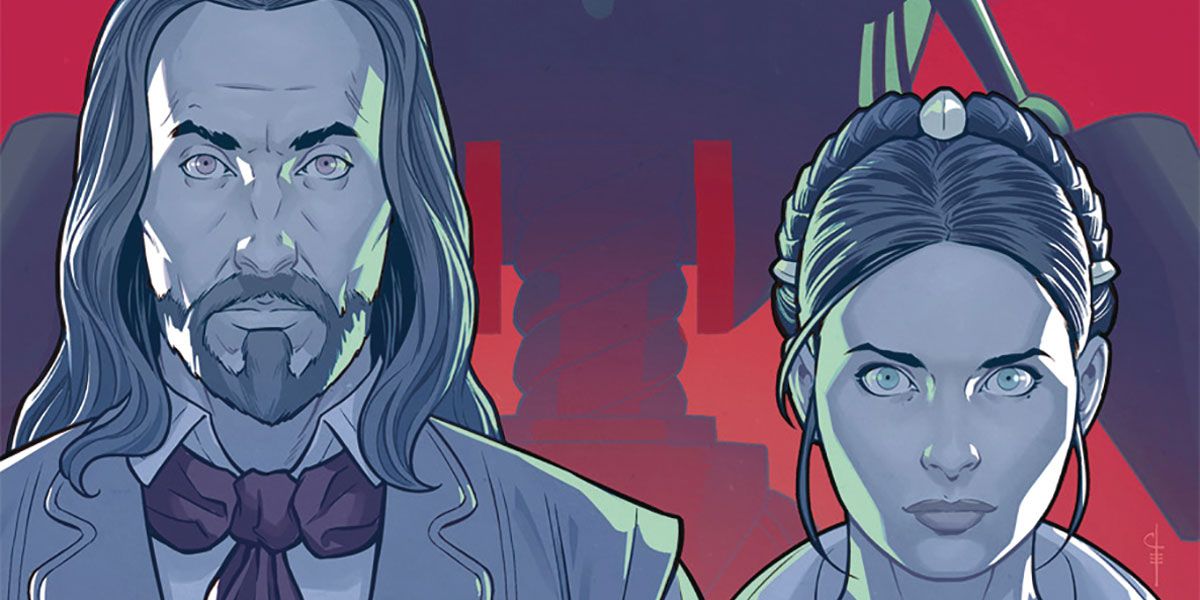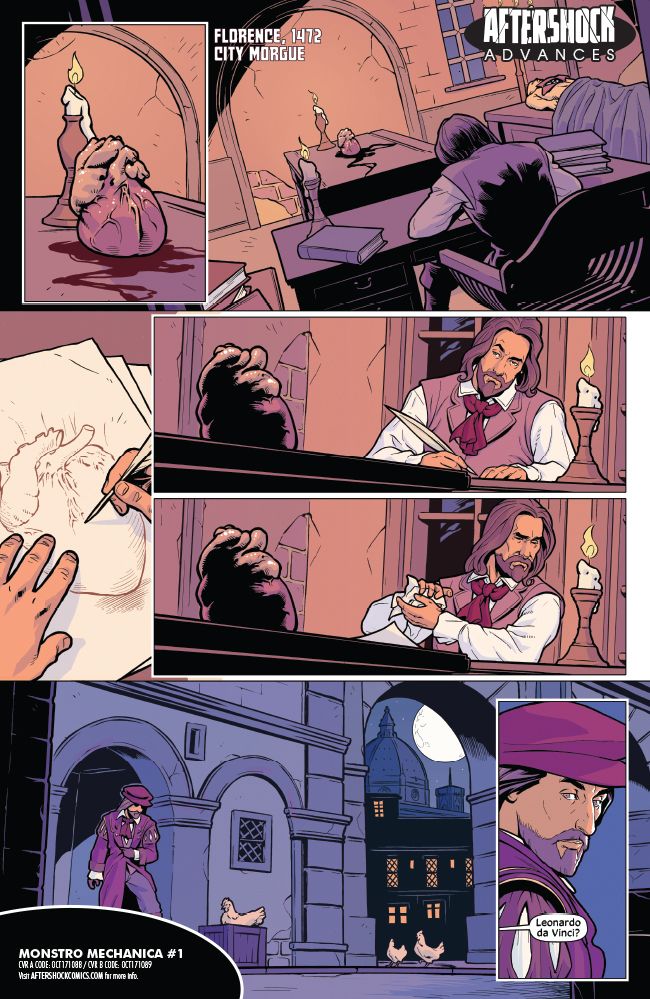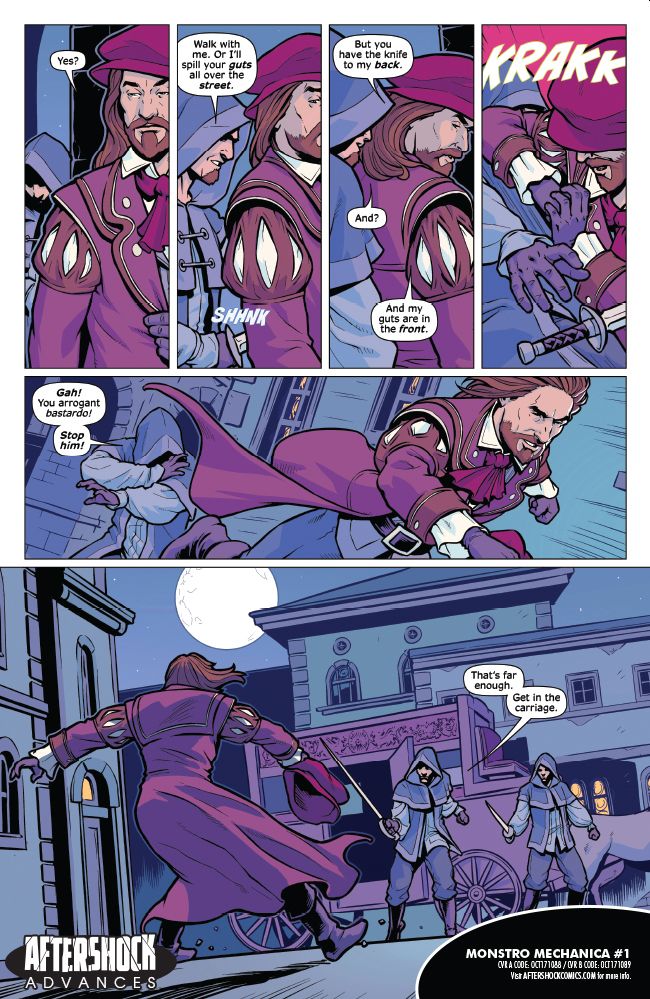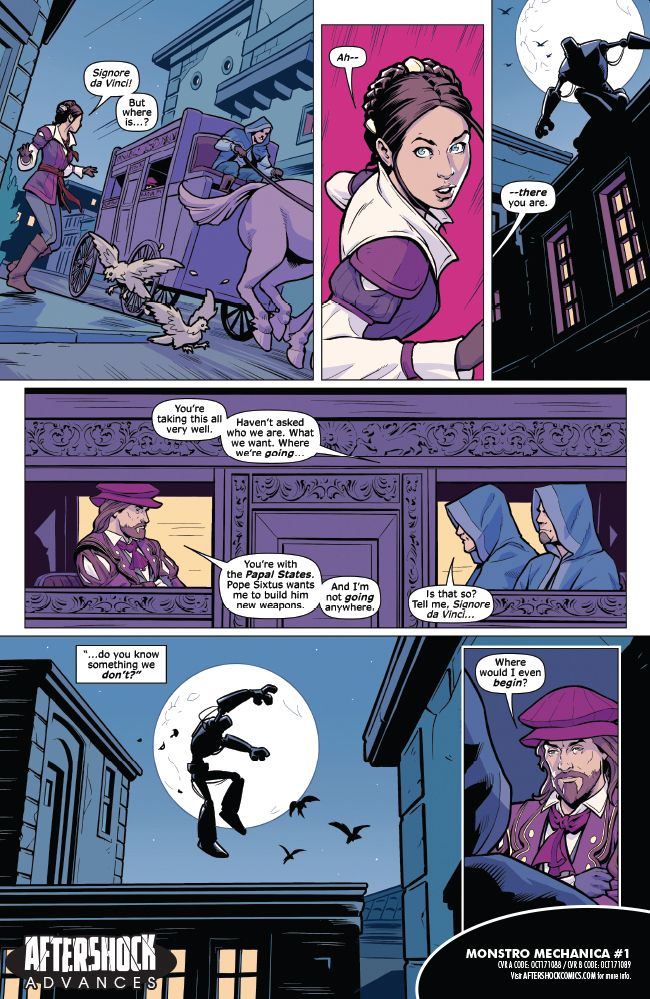Leonardo da Vinci's extraordinary life as the quintessential Renaissance man remains as much a mystery now as it was a marvel at the time. He suggested and predicted machinery and concepts far beyond the ability of anyone in the era. Creative and inventive, his life and times have hit the comics page more than once over the years, with different writers and artists taking grasp of his frilly ruffs and attempting to get inside his head.
RELATED: AfterShock Editor-in-Chief on the Company’s Progress So Far
The latest comics take on da Vinci is from writer Paul Allor and artist Chris Evenhuis, along with colorist Sjan Weijers. Their new AfterShock series Monstro Mechanica pairs da Vinci with an apprentice, Isabel, but whilst da Vinci takes a leading role, the most interesting part of this story is Isabel's role as apprentice -- and moral opponent to the direction her mentor is heading in. Even as da Vinci heads further towards creating instruments of modern warfare, the series sees Isabel slowly, quietly working to undermine him in the event that one day she has to take him down. He may be building the future, but she's rewriting that big wooden robot he made a few years ago, and eventually she knows that she's going to have to use it to end da Vinci for good.
It all sounds dramatically different from other takes on da Vinci audiences have seen before -- especially that cool wooden robot bit -- so to find out more, CBR spoke to Paul and Chris about the series.
CBR: What can readers expect from Monstro Mechanica? What kind of story are you building here?
Paul Allor: We’ve been calling Monstro Mechanica a swashbuckling meditation on identity about Leonardo da Vinci, a girl, and her robot, which I think sums it up nicely. We’re aiming to be simultaneously cerebral and kinetic, meditative and action-packed.
More practically, it’s a Renaissance sci-fi story about a Leonardo da Vinci who builds weapons for both sides of a cold war just as it's starting to simmer. Meanwhile his young apprentice, Isabel, can see that this isn’t going to end well. One of her main tasks is the care and maintenance of da Vinci’s robot bodyguard -- but instead of resetting it, she’s slowly "waking it up", so that when the time comes she can save the world from Leonardo -- and Leonardo from the world.
So, that’s our elevator pitch. Assuming it’s a rather long elevator ride. That’s our Burj Khalifa elevator pitch.
Chris Evenhuis: Hopefully, it’s a fun and tense ride that will leave you thoroughly entertained, and also keep you awake at night thinking about stuff like how we need to be weary of empathizing only with those who resemble ourselves.
Allor: Fun!
The series is set at a turning point for the modern world, really. With people fighting to get their hands on da Vinci’s work and put themselves in control of the future, what interested you in building a story around this specific point in time, and this specific conceit?
Allor: The Renaissance was, in many ways, the birthplace of our modern conception of the self -- the idea that every individual has an inherent importance, beyond just the role they place in society. So I was very attracted to the notion of pairing that with a very classic sci-fi story of a robot gaining sentience.
It was a time when people were exploring -- pushing the boundaries of art, of science, of engineering, and the literal boundaries of where their particular cultures had gone before. And over all of this was -- as you said -- several different factions trying to put themselves in control of this exciting new future. It’s a fantastic setting.
Why go to AfterShock for this story? What made them the home for Monstro Mechanica?
Allor: AfterShock really does represent the best of both worlds when it comes to creator-owned comics: they have an extraordinary depth of talent and experience, from editorial to marketing to retailer relations, while also being truly dedicated to creator-owned comics, to giving their creators the freedom to push the boundaries, and put their unique visions into print. I was also thrilled to work with editor Mike Marts, who’s overseen so many books that have meant so much to me over the years.
How did you come together for the story? Was this a story you’ve had in mind together for a while?
Evenhuis: After working on a G.I. Joe short together four years ago, we kept in touch, started talking about pitch ideas for creator-owned books. I mentioned enjoying working on period settings as an artist, drawing/designing costumes and old architecture. One of the settings that came up was Renaissance Italy; for me initially mostly from an aesthetic point of view, but then Paul suggested, "Leonardo da Vinci and his female apprentice building a sci fi robot," and I was like, "Yes!"
Allor: That’s about how I remember it as well! Chris’ work is so extraordinary -- that beautiful clean-line style, amazing acting and character work, absolutely fantastic layout and design, all adding up to crystal-clear storytelling. I feel like Chris could do just about any story I threw at him. But what really appealed to me about this, in particular, was my desire to make this story feel very modern and pop. Historical fiction can so often feel stodgy, more homework than pleasure, and I knew Chris would fight against that, breathing life into every page, panel and moment.
And Sjan Weijers, our extraordinary colorist, is making this book look so bright and beautiful, with a palette and style that underscores the Pop Culture feel we were going for. Put it all together, and I truly think we have something special, here.
Page 2: [valnet-url-page page=2 paginated=0 text='Designing the Series, Understanding da Vinci']
We’ve seen several fictionalized versions of Leonardo da Vinci over the years -- heroic, villainous, everything in between. What is it that makes him such a compelling figure in history, even now?
Allor: I think it’s the fact that he was so far ahead of his time -- centuries ahead, in some cases -- in so many different ways. There are a lot of folks who caught a glimpse of the future in one aspect or another, but the breadth of da Vinci’s work, the depth of his prescience, is so breathtaking that it truly does seem almost supernatural. Aside from (perhaps) certain religious figures, who else in human history is as otherworldly as Leonardo da Vinci?
How have you approached the design of the series? How do you go about creating work which feels like it could have come from the mind of someone like da Vinci?
Evenhuis: Starting out, we were thinking of going for a fully retro Forbidden Planet sci-fi look with Art Deco elements mixed in with the Renaissance design. It was very ambitious. A lot of the look developed on the fly as well: while working on the opening scene, we started talking about '80s Spielberg directing/editing, so that started creeping in, also in the coloring, I think. In any case, we wanted to make everything look more vibrant and fresh than you'd maybe normally expect from historical fiction.
As for da Vinci's machines, I studied the designs from his notebooks and mostly stuck pretty close to them; mixed/matched some elements elsewhere, but made sure the main ingredient for his inventions would be wood, including the robot.
How does your version of da Vinci think? What kind of a man is he?
Evenhuis: Who knows?
Allor: [Laughs] There’s some truth to that -- we want him to be a bit ambiguous to the reader, at least at first. I will say that he’s probably a bit more sinister than you would expect. Or, you know… a lot more sinister, with a certain ruthlessness to the way the thinks. We also tried to give him a touch of the weird and the otherworldly.
There’s also a bit of a running gag throughout the book, that could best be summed up as: "Leonardo da Vinci... he’s just like every other artist!" So when we first see him, he’s crumpling up a sketch out of frustration. Later he gets excited about a new project, but then immediately acknowledges that he’d probably never get around to it. That sort of thing.
You also mention his apprentice, Isabel. How important is she to the story, and how does her dynamic with Leonardo build as the series starts out?
Allor: Their relationship is very much mentor and student -- but Leonardo is a bit of a temperamental and quixotic mentor, preferring to let her figure most things out on her own.
Isabel has her own point of view, her own way of thinking and her own agenda -- one that sometimes aligns with da Vinci’s, but often doesn’t. But as a result of this, she’s one of the few people able to see through da Vinci’s manipulations, and call him on them. She challenges him, and he appreciates that.
Another thing that lies at the core of their relationship is da Vinci’s immense trust in Isabel. He often withholds crucial information from her, and sends her into situations that are immensely dangerous, and might seem downright stupid. But he does it because he trusts her to take care of herself; to find her way to safety, and learn a valuable lesson or two in the process.
Whilst talking about dynamic, how have you found the collaborative process so far?
Evenhuis: It's been an absolute joy. I think Paul is truly one of the best writers in the industry. His work has rock solid structure, strong visual storytelling, is layered with captivating nuances, super respectful to its characters and manages to strike a unique balance between melancholy and funny. But what I respect the most is how he seems to do it all in a deliberate, understated way, never sidestepping for an easy "score;" he's definitely no show-off. When he introduces a big moment, he makes sure it's fully earned and it kicks you right in the soul. Plus, working together has been like an ongoing dialogue from the beginning; very inspiring.
Allor: Working with Chris and Sjan has been such a constant pleasure, and it’s good to know that the inspiring nature of it is mutual! From the start there's been a tremendous amount of back-and-forth, as we build off one another's ideas to develop this story.
For example, giving Isabel pants was initially a design choice on Chris' part, but it dovetailed nicely with some things I read about women's behavior in that time period, and the reasons why some women would eschew dresses, so we incorporated that into the story.
And back when I was still writing issue #1, Sjan first raised the question of whether the machine is meant to represent a male or a female. It made us realize that we had definitely defaulted to thinking of the machine as a male, for all the same reasons that Isabel mentions in issue #1. And that issue, obviously, became a major thread that runs throughout the comic.
The bottom line is, this has been such a true collaboration, just an amazing back-and-forth, and one of the great pleasures of my comics career, every step of the way.
Monstro Mechanica #1 is on sale now.





